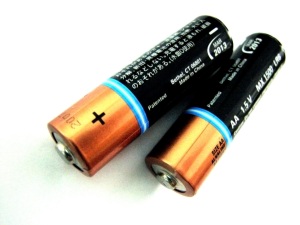Saturday, December 1, 2012
Thursday, November 29, 2012
微生物
人体共生微生物关涉人类心理及身体健康
从行为生物学研究角度上看,我国目前在心理疾病和行为异常控制方面面临着各种严重问题,其解决方案不是需要更多的心理医生或咨询师,也不是增加医疗机构和改善生活水准,而是药物滥用和食品安全的问题。从人体微生物角度上来说,越是保鲜力强的食品越是对人体共生微生物的毒害作用大。

随着科学的发展和人们对心理学的深入了解,研究者从物种起源进化分化的层面上发现,思想和行为的变化不仅取决于人类遗传因素,还取决于与其相互作用的环境因素。城市化使生活环境发生根本改变、教育引导人们对卫生问题的观念发生变化、经济上彻底改变城镇居民的饮食习惯等外环境因素可能成为心理学和行为学更值得关注的内容。上述环境变量与“卫生假说”有着不可分割的联系,都可能引起人类行为的变化。几年前,我们在心理学领域引入了行为生物学,它关注水平感染等领域的研究,不同于垂直传递的行为遗传学科。
About Constellations
What's a constellation?A constellation is a group of stars that appears to form a pattern or picture like Orion the Great Hunter, Leo the Lion, or Taurus the Bull. Constellations are easily recognizable patterns that help people orient themselves using the night sky. There are 88 “official” constellations.
Are the stars in a constellation near each other?Not necessarily. Each constellation is a collection of stars that are distributed in space in three dimensions – the stars are all different distances from Earth. The stars in a constellation appear to be in the same plane because we are viewing them from very, very, far away. Stars vary greatly in size, distance from Earth, and temperature. Dimmer stars may be smaller, farther away, or cooler than brighter stars. By the same token, the brightest stars are not necessarily the closest. Of the stars in Cygnus, the swan, the faintest star is the closest and the brightest star is the farthest!
How are constellations named?Most of the constellation names we know came from the ancient Middle Eastern, Greek, and Roman cultures. They identified clusters of stars as gods, goddesses, animals, and objects of their stories. It is important to understand that these were not the only cultures populating the night sky with characters important to their lives. Cultures all over the world and throughout time — Native American, Asian, and African — have made pictures with those same stars. In some cases the constellations may have had ceremonial or religious significance. In other cases, the star groupings helped to mark the passage of time between planting and harvesting. There are 48 “ancient” constellations and they are the brightest groupings of stars – those observed easily by the unaided eye. There actually are 50 “ancient” constellations; astronomers divided one of the constellations (Argo) into 3 parts.
“Modern” constellations — like the Peacock, Telescope, and Giraffe — were identified by later astronomers of the 1500s, 1600s, and 1700s who used telescopes and who were able to observe the night sky in the southern hemisphere. These scientists “connected” the dimmer stars between the ancient constellations. There are 38 modern constellations.
In 1930 the International Astronomical Union officially listed 88 modern and ancient constellations (one of the ancient constellations was divided into 3 parts) and drew a boundary around each. The boundary edges meet, dividing the imaginary sphere — the celestial sphere — surrounding Earth into 88 pieces. Astronomers consider any star within a constellation boundary to be part of that constellation, even if it is not part of the actual picture.

Are all stars part of a constellation?No, there are billions of stars, and only a fraction of them make up the shapes of our constellations — these are the stars that are easily seen with the unaided eye. Ancient observers connected these stars into the star pictures.
All stars, however, fall within the boundaries of one of the 88 constellation regions. As astronomers studied the night sky with modern telescopes, they were able to discern stars in the dark spaces around the constellations — stars that were not part of the original star pictures. You can see some of these stars by observing the sky on a dark night. If you look at the sky with binoculars, you will see even more stars. If you have a telescope, you will see even more! All the stars you see belong to one special group of stars — the stars in our own galaxy, the Milky Way.
How are stars and other objects in the sky named and located?Hundreds of the brightest stars, those visible with the unaided eye, were given names in ancient times. These include Eltanin of Draco, the Dragon, and Vega in Lyra, the Lyre. Many of these stars have multiple names, having been observed by different cultures.
Today stars are named by their coordinates on the celestial sphere. This is an imaginary sphere surrounding Earth. Earth’s north and south poles can be extended in space to this sphere, marking the north and south celestial poles, the poles around which the sphere spins. Polaris marks the intersection of the extended north pole and the sphere. Earth’s equator, extended into space, intersects the sphere at the celestial equator, dividing it into northern and southern hemispheres. All stars and objects in space, such as constellations, can be mapped relative to the poles and equator of the celestial sphere. Their position north or south of the celestial equator — essentially their latitude — is called “declination.” Their position east or west essentially is their longitude, or right ascension, measured in hours, minutes, and seconds. On Earth, we measure our longitude east or west from Greenwich, England; right ascension on the celestial sphere is measured from the intersection of the ecliptic (plane of Earth’s orbit) and the celestial equator.
There are numerous catalogs of stars, each with a different scheme for annotating position; this means that each star has even more names! One of the most famous catalogs from the 1800s, the Bonn Survey, divides the sky into 1°-wide bands of declination and numbers the stars from west to east using right ascension. In the Bonn Survey ("Bonner Durchmusterung"), Vega is "BD+38° 3238” — the 3238th star in the band between 38° and 39° north. Another catalog, the Smithsonian Astrophysical Observatory (SAO) catalog, integrated 10 catalogs to include the positions of over 250,000 stars. Vega is SAO 067174 in this catalog. The Hubble Space Telescope has allowed astronomers to see even more stars! The Hubble Space Telescope Guide Star Catalogue currently lists the coordinates of over 19 million bright objects — 15 million of which are classified as stars!

Illustration of the components of the celestial sphere.
Why Do Most Stars and Constellations Move?
The stars are distant objects. Their distances vary, but they are all very far away. Excluding our Sun, the nearest star, Proxima Centauri, is more than 4 light years away. As Earth spins on its axis, we, as Earth-bound observers, spin past this background of distant stars. As Earth spins, the stars appear to move across our night sky from east to west, for the same reason that our Sun appears to “rise” in the east and “set” in the west.
The stars are distant objects. Their distances vary, but they are all very far away. Excluding our Sun, the nearest star, Proxima Centauri, is more than 4 light years away. As Earth spins on its axis, we, as Earth-bound observers, spin past this background of distant stars. As Earth spins, the stars appear to move across our night sky from east to west, for the same reason that our Sun appears to “rise” in the east and “set” in the west.
Stars close to the celestial poles, the imaginary points where Earth’s north and south axes point in space, have a very small circle of spin. So if you find Polaris, Earth’s north “pole star,” you will observe it move very, very, very little in the night sky. The farther from Polaris, the wider the circle the stars trace. Stars that make a full circle around a celestial pole, like those in the Big and Little Dippers in the northern hemisphere, are called “circumpolar stars.” They stay in the night sky and do not set. At the equator, there are no circumpolar stars because the celestial poles are located at the horizon. All stars observed at the equator rise in the east and set in the west.
Why Do We See Different Constellations During the Year?
If observed through the year, the constellations shift gradually to the west. This is caused by Earth’s orbit around our Sun. In the summer, viewers are looking in a different direction in space at night than they are during the winter.
What is the Zodiac?
Earth orbits our Sun once each year. Viewed from Earth, our Sun appears to trace a circular path. This path defines a plane called the plane of the ecliptic (or just the ecliptic). The zodiac is the group (or “belt”) of constellations that fall along the plane of the ecliptic. It is through these constellations that our Sun appears to “pass” during the year. While there are 12 astrological constellations of the zodiac, there are 13 astronomical zodiac constellations: Capricornus, Aquarius, Pisces, Aries, Taurus, Gemini, Cancer, Leo, Virgo, Libra, Scorpius, Sagittarius, and Ophiuchus. The annual cycle of the zodiac was used by ancient cultures to determine the time of year.
Earth orbits our Sun once each year. Viewed from Earth, our Sun appears to trace a circular path. This path defines a plane called the plane of the ecliptic (or just the ecliptic). The zodiac is the group (or “belt”) of constellations that fall along the plane of the ecliptic. It is through these constellations that our Sun appears to “pass” during the year. While there are 12 astrological constellations of the zodiac, there are 13 astronomical zodiac constellations: Capricornus, Aquarius, Pisces, Aries, Taurus, Gemini, Cancer, Leo, Virgo, Libra, Scorpius, Sagittarius, and Ophiuchus. The annual cycle of the zodiac was used by ancient cultures to determine the time of year.

Illustration of the “zodiac band” with a few of the constellations depicting the objects they represent.
Most of the planets (except Pluto) also have orbits that are very close to the ecliptic plane defined by Earth’s motion (within about 8 degrees above or below). If you include all the constellations encompassed by this broadened definition of the ecliptic plane, you have 21 to 24 constellations of the zodiac!
Why Don’t the Constellations Line Up with the Astrological Dates?
The astrological signs were identified and connected to the calendar about 2500 years ago. However, since that time, the timing of Earth’s seasons has shifted. This is partly due to the fact that Earth wobbles a little like a top, making its axes point in different directions at different times. This is a predictable cycle of change over a period of about 23,000 years. Today the northern hemisphere winter solstice occurs during aphelion, when Earth is farthest from the Sun; about 6000 years ago, the spring equinox occurred during aphelion. Through time, then, the seasons have shifted with respect to the background of the zodiac constellations. Five thousand years ago, our Sun passed through Taurus during the spring equinox; today it is in Pisces at the start of spring. So if you ever wonder why your horoscope may be off a bit … perhaps by several thousand years … this shift may be the reason!
The astrological signs were identified and connected to the calendar about 2500 years ago. However, since that time, the timing of Earth’s seasons has shifted. This is partly due to the fact that Earth wobbles a little like a top, making its axes point in different directions at different times. This is a predictable cycle of change over a period of about 23,000 years. Today the northern hemisphere winter solstice occurs during aphelion, when Earth is farthest from the Sun; about 6000 years ago, the spring equinox occurred during aphelion. Through time, then, the seasons have shifted with respect to the background of the zodiac constellations. Five thousand years ago, our Sun passed through Taurus during the spring equinox; today it is in Pisces at the start of spring. So if you ever wonder why your horoscope may be off a bit … perhaps by several thousand years … this shift may be the reason!
An Interesting Tidbit
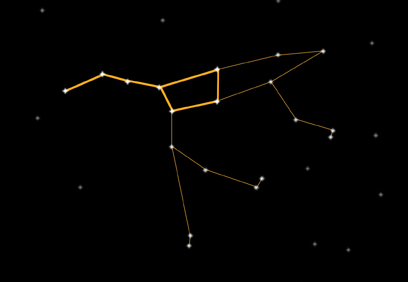
The Big Dipper is not a constellation! It is part of Ursa Major, the Greater Bear.
The Big Dipper is an asterism, a recognized, but not official, grouping of stars.
Some asterisms fall within a single constellation, others cross constellations
The Big Dipper is an asterism, a recognized, but not official, grouping of stars.
Some asterisms fall within a single constellation, others cross constellations
alkaline food
Why Alkaline Foods Are Important
Your health depends on the balance of an alkaline environment, created by eating foods such as tomatoes, avocados and green vegetables…striking the optimum 80/20 balance and regulating your body’s acid/alkaline chemistry through simple changes in diet can result in weight loss, increased stamina and strength, a stronger immune system and a greater sense of well-being.
1. SPINACH -All leafy greens should be eaten in abundance but spinach is my absolute favourite because it’s easy to buy, easy to use in recipes and salads and is delicious. Baby spinach or fully grown spinach are Nutritional powerhouses and are incredibly alkaline. As with all green foods, spinach is rich in chlorophyll (see more about the health benefits of chlorophyll here), a potent alkaliser and blood builder. It is also super high in vitamin K, vitamin A, manganese, folate, magnesium, iron, vitamin c, vitamin b2, calcium, potassium, vitamin e, dietary fiber…I doubt there is a more all round healthy food on earth and I highly encourage you to eat spinach throughout the day, every day.
2. KALE -Kale is another leafy green beauty that is widely known for its Cancer-Fighting, Cholesterol-Lowering, Antioxidant-rich, and Detoxifying goodness. Less popular than spinach, but only because it has a history of being cooked poorly (like cabbage) – when done right it is absolutely delicious (see recipes below, you’ll thank me). If you eat kale 2-3 times per week you’ll know it. Like spinach it is massively high in vitamin K, vitamin A and vitamin C and being Leafy Green it also has a huge Chlorophyll content. The reason it is so powerful against the Cancer Fight is that kale contains at least four Glucosinolates. I don’t want to lose you here by using words like glucosinolates – all you need to know is that as soon as you eat and digest kale, these glucosinolates are really easily converted by the body into cancer fighting compounds. Also quite amazing for Lowering Cholesterol, it should be noted that steamed kale is more effective for cholesterol lowering than raw.
3. CUCUMBER The beauty of cucumber is it’s water content – 95%. That is phenomenal and you won’t find that anywhere else. It’s the daddy of water-content. This of course makes it an incredibly hydrating food to consume, that ALSO contains superb amounts of antioxidants, including the super-important lignans. These highly beneficial polyphenols have more commonly been associated with the cruciferous vegetables, but their content in other veggies such as cucumbers is gaining more and more attention. Cucumbers contain a right load of lariciresinol, pinoresinol, and secoisolariciresinol , three lignans that have a huge and very strong history of research in connection with Reduced Risk of Cardiovascular disease as well as several cancer types, including Breast, Uterine, Ovarian, and Prostate Cancers. The best thing about cucumber is that they provide the base for practically every alkaline soup, smoothie and juice – giving you a very alkaline, very nutritious base that also tastes great. In terms of the actual nutrient RDA per serve, cucumbers contain fair amounts of vitamins K and C, and slightly less of vitamin A and the B vitamins. Cucumbers also contain the following alkaline minerals: calcium, iron, phosphorus, potassium, magnesium, selenium, copper, manganese, iron and zinc.
4. BROCCOLI – Broccoli is just a must. If you are serious about living with health, energy and vitality you simply have to eat broccoli, if not on a daily basis, then at least 4 times per week. Broccoli has been proven over and over and over again to be incredibly powerful in inhibiting Cancers, supporting the Digestive System, the Cardiovascular System, the Detoxification processes in the body and also supporting the Skin, metabolism, İmmune system, being an Anti-Inflammatory and providing ample Antioxidants. Eaten steamed or raw its a Hugely Alkaline, Hugely Nutritious food. Please, please, please eat lots and lots of it. Put it in salads, juices, smoothies, soups…steam it with other veggies – you can even roast
5. AVOCADO -I eat a LOT of avocado. Not a salad, smoothie or soup goes by without me adding at least 1/2 an avocado per person. I probably eat at least five-seven per week, myself. Now, I know a lot of people give avocado a bad rep because it is a high-fat food (85% of it’s calories come from fats) – but this is totally insane. These are good fats that will not make you gain weight. If anything, due to the high content of oleic acid (making it an Omega 9 fat and very similar to olive oil), it can lower total cholesterol level and raise levels of high-density lipoproteins (HDLs) while lowering low-density lipoproteins (LDLs), also known as the “bad” cholesterol. Oleic Acid also slows the development of heart disease, and promotes the production of Antioxidants. These beneficial omega oils also help speed the metabolism, actually leading to weight loss rather than gain. So now we’re over the fat issue, avocado also contains a wide range of other nutrients that have serious Anti-İnflammatory, Heart Health, Cardiovascular Health, Anti-Cancer, and Blood Sugar Benefits. Containing key Antioxidants such as alpha-carotene, beta-carotene, lutein, selenium and more – it is a powerful, alkaline, nutrient-dense superfood.
6. CELERY – Celery, like cucumber is a favourite because it’s alkaline AND really high water content, so is used very frequently as a base in juices and soups (not so much smoothies as you have to juice it first…and then you have double the washing up). One of celery’s big benefits is it’s vitamin C level, which has the well known benefits – but two of it’s lesser known nutrients are phthalides which have been shown to Lower Cholesterol and coumarins which have been shown to inhibit Several Cancers. The beauty of vitamin C rich foods are that they help with the most common and most challenging health concerns – they support the İmmune system, inflammation (so helps with Arthritis, Osteoporosis, Asthma etc), and vitamin C also helps significantly with Cardiovascular Health. If you are on a weight loss journey, you’ll also be happy to hear that this alkaline staple contains plenty of potassium and sodium and so is a diuretic – meaning it helps rid the body of excess fluids.
7. CAPSICUM / BELL PEPPER / PEPPER – The antioxidant superpower, bell pepper is one of my all-time-favourites because it is sweet, crunchy and refreshingly delicious. You can use it in almost any meal raw, grilled, fried, and roasted and it is always a winner. Impressively beneficial to our health cartenoids are highly researched and get a lot of attention in the health field and bell peppers contain over 30 different members of the carotenoid nutrient family. The only other food that is close to this is Tomato and all other foods are also-rans. Bell peppers have shown up in research relating to decreasing the risk of Cardiovascular Disease, type II Diabetes, Macular Degeneration, Cancer, inflammation and more. Alongside these lesser known or more complex-named antioxidants, bell pepper is one of, if not the best food source of the more common antioxidants: vitamin C, vitamin A and vitamin E. In fact, bell peppers contain twice as much vitamin C as oranges. Here are just SOME of the antioxidants bell pepper contains: – Flavonoids – luteolin – quercetin – hesperidin – Carotenoids – alpha-carotene – beta-carotene – cryptoxanthin – lutein – zeaxanthin – Hydroxycinnamic Acids – ferulic acid – cinnamic acid
Are you Acid or Alkaline
Do you know your pH?
All organic matter on our planet has a pH level and yes, that includes us!! A pH level of 7.0 is neutral, which means that anything below 7.0 is considered acid, and anything above is alkaline. Neutral is a wonderful thing, in this case.
pH is the acronym for “potential of Hydrogen.” Basically, your pH level determines your personal acid to alkaline ratio.
Human blood is slightly alkaline at around 7.40. It is important to strive for balance, as we do not want to be too acid or too alkaline. (Being too alkaline is less common).
Why do we want a balanced or neutral, pH? In the simplest of terms, if our bodies are too acid, it means that their is an accumulation of acidic waste in our cells, human tissue, organs, glands, etc… This, of course, is not a good thing.
Acid is a host for bacteria and invites disease into the body. A neutral or slightly alkaline body cannot be a host for disease. Thus, why we must strive for balance.
How can we create this balance? There are many factors that influence our pH levels in the body. Having a poor diet and too much stress will cause a dangerous imbalance. (It is easy to test your pH balance with litmus paper. For now though, you will be able to determine your pH just by analyzing the foods you eat on an everyday basis- use the chart below).
Below is a rather rough diagram to help you determine whether your diet is alkaline or acid.
Here is the wonderful news: You can control your pH. Without getting caught up, or stressing about whether certain foods are, or are not, acid, you can make a drastic improvement in your diet by taking these few steps:
- Decrease (or eliminate) consumption of sodas, coffee, non-herb tea, candy, chocolate, milk, animal protein, cheese, starch and alcohol.
- Always buy organic, non-homogenized, milk.
- Choose a raw goat cheese from a trusted source, instead of pasteurized cow milk cheese.
- Avoid processed snacks and fried foods.
- Order the grilled chicken or fish with a side of vegetables instead of the fried chicken with fries.
- Snack on raw nuts (like almonds) and seeds (like sunflower or pumpkin) instead of peanuts, candy or protein bars.
- Concentrate on eating more vegetables, green things, fruit, and high-quality grain, and sprouted-grain products (like Kamut pasta or Ezekiel brand bread).
- Make your own salad dressings from first-cold pressed olive oil, instead of buying the pre-made stuff that contains hidden sugars and bad oils like, soybean oil.
- Use Stevia and raw honey in place of sugar and artificial sweeteners.
- Use organic butter instead of margarine and sea salt instead of iodized table salt.
- Add avocado to your sandwich instead of mayonnaise.
- If you are going to enjoy wine at dinner, load up on the vegetables.
For beginners, it is all about creating balance. I am not saying that you need to give up your red meat, wine and chocolate.
There are a million and one ways you can improve your pH level and thus, health and still enjoy life. How do you strive to maintain a healthy balance? What “acid”-forming foods have you traded in for a more alkaline alternative.
MAGNETISM
Magnetism in Technology
Magnetism is a huge part of some very advanced technologies that make a big difference in our world. Let's take a look at a few important technologies where magnetism plays a big role.
Hard Drives
Hard drives are an important part of any computer system, and magnetism is the key behind how they work. Hard drives uses disks made of magnetic material, called platters, to store information.
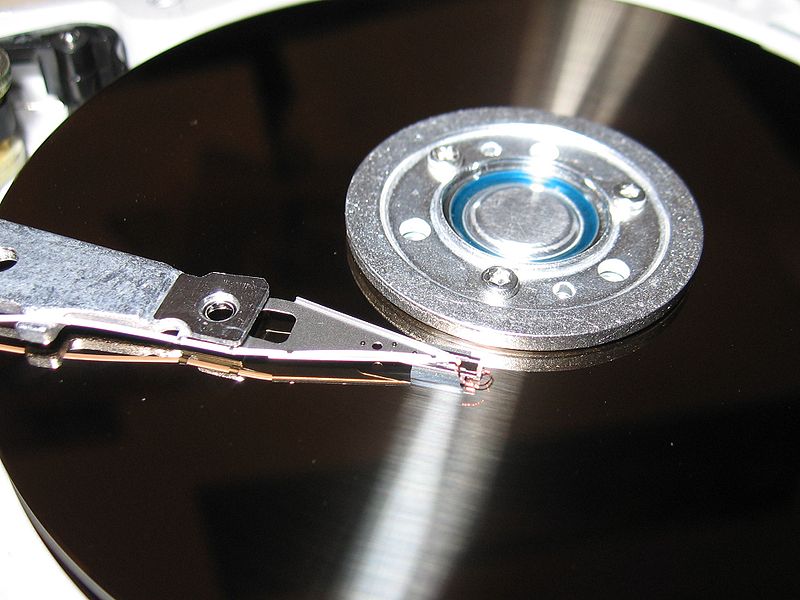

A Hard Drive Platter ©Wikipedia Commons Read/Write Head © Wikipedia Commons
Read/Write Head © Wikipedia Commons
An electromagnet in the read/write head writes writes information to the disk by magnetizing small sections of the disk, called sectors, in a one direction or another to indicate a 1 or a 0. The same read/write head also detects the orientation of these sectors when reading information from the disk. Previously, the sectors on the platters were magnetized parallel to the surface of the platter. This style of recording was called longitudinal recording.

However, a breakthrough was made by magnetizing the platters perpendicular to the platter, allowing for more information to be stored in the same amount of physical space.This new style, called perpendicular recording, has allowed for hard drive capacities to increase greatly.
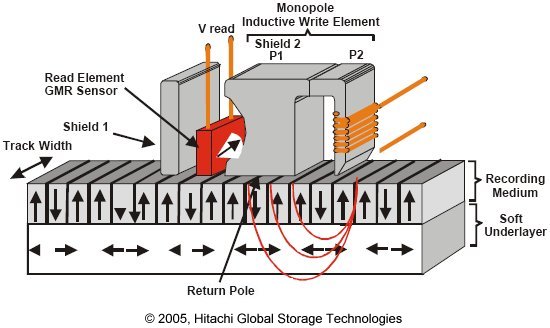
Check out this video from Hitachi Global StorageTechnologies to learn more about new method of recording.
Magnetic Resonance Imaging (MRI)
Magnetic Resonance Imaging is an example of magnetism being applied in the medical field. This technology is a type of medical imaging that uses magnetism and the large percentage of water in the human body to produce detailed images of human body tissue and structures. MRI images are high in contrast, and allow doctors to examine different types of tissues in a region of the body more easily and accurately.
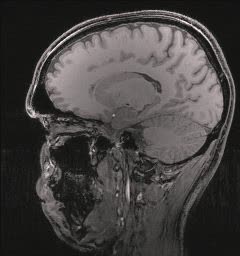 An MRI image of a human head. © Daniel Schwen
An MRI image of a human head. © Daniel Schwen
MRI machines place the patient in the center a long cylinder surrounded by large, powerful permanent magents, electromagnets, and sometimes superconducting magnets, along with many coils of wire.
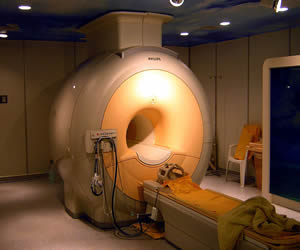 An MRI machine. © Wikipedia Commons
An MRI machine. © Wikipedia Commons
Once the body is inside the machine, the water molecules (specifically the hydrogen atoms) inside the body are magnetized in the same direction by a large magnetic field. Then, a radio frequency pulse is directed towards the specific region of the body being examined. Different types of body tissue respond to different frequencies. The radio frequency energizes the hydrogen atoms of a specific tissue and causes them to flip out of alignment from the rest of the hydrogen atoms in the body. When the radio frequency is removed, the disturbed hydrogen atoms slowly return to the magnetized state. As they return to the magnetic field of the machine, they release the energy they recieved from the radio frequency. The coils of wire in the machine detect the energy released, and an image is formed the detected bursts of energy.
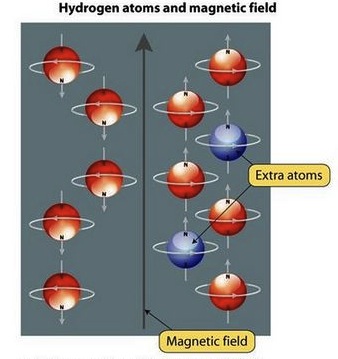
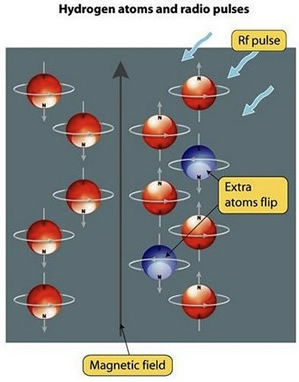
Magnetic Levitation (MagLev) Trains
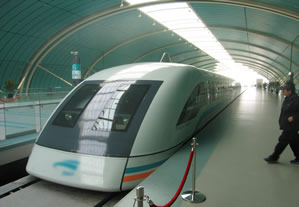
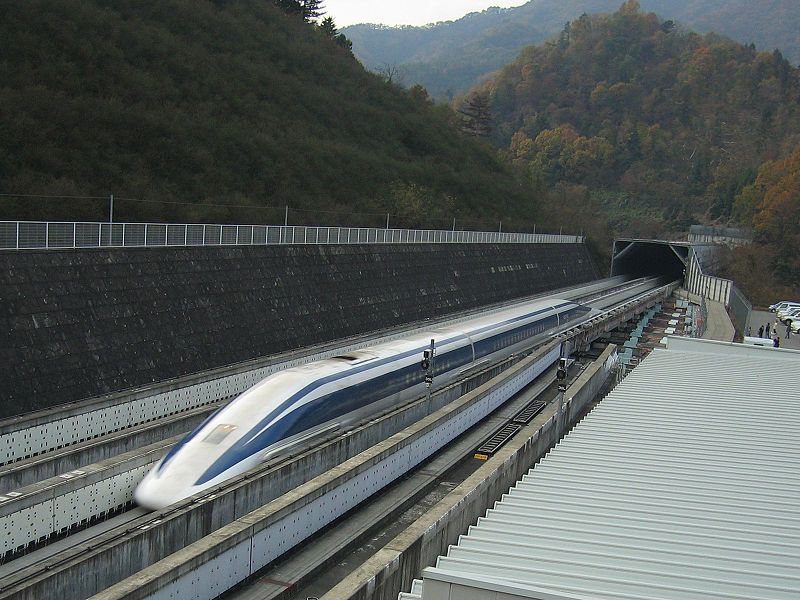
Shanghai Transrapid ©Wikipedia Commons  JR-MLX01 Maglev Train ©Wikipedia Commons
JR-MLX01 Maglev Train ©Wikipedia Commons
Magnetic levitation trains, more commonly called MagLev trains, are a technology that could bring big changes to the way we travel in the future. These trains use magnetism to "float" without friction on top of a special track, creating a faster and more efficient method of transportation. These trains are capable of reaches speeds greater than 300 mph, and are much more energy efficient than other forms of travel.
In general, maglev trains have a magnetic track that repels other magnets placed on the train, allowing the train to float above the track. Other magnets are placed on the sides of the train and the sides of the track to keep the train on course and prevent it from leaving the track. A traveling magnetic field is then used to propel the train forward.
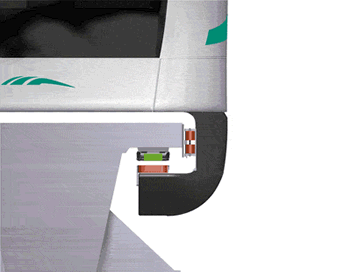

There is currently one Maglev system open and running commercially, the Transrapid in Shanghai, China. The Transrapid is a German design that uses electromagnets in the train car and track to provide the lift and propulsion force necessary to move the train. Other designs are currently being developed as well. In Japan, the Central Japan Railway Company's JR-MLX01 train uses superconducting magnetic coils in the train instead of regular electromagnetic coils. This type of system is called an electrodynamic system. The JR-Maglev design set the current Maglev speed record at 361mph. Finally, a third design is being developed by the Lawrence Livermore National Laboratory in California. This design, called Inductrack, aims to lift and propel the train without constant electrical energy being used in the track or the train.
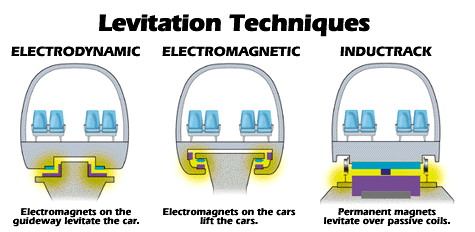
This design uses special arrangements of permanent magnets on the train and coils of wire in the track. Although a small external force is required to get the train moving at first, once the train reaches a minimum speed, the motion of the train will induce currents in the coils of wire insdie the track that will provide the lifting force needed to float the train.Therefore, no long-term power supply is needed to support the train, just its own motion. While a full model has not been built using the Induct
Shanghai - Maglev
ELECTRICITY


1) what is electricity? Electricity is the flow of electrical charge.Electricity is the most basic part of nature because it does so many jobs for us. It powe.rs our homes,televisions,computers,and cools our homes and is a big part of the economy
2) Why is electricity important to us? Because if we had no electricity we wouldn't be able to see.And we could not do our work and if we didn't have electricity we wouldn't have computers,tv's etc..
3) How do you use Electricity? Retail and service buildings use 149 billion kWh (or 508 trillion Btu) of site electricity (electricity consumed within the building) each year. This electricity is used for a variety of different purposes, the most being used for lighting.
4) How do we use Electricity? Millions of years ago, the remains of plants and animals built up in thick layers. This decayed matter from plants and animals is called organic material -- it was once alive. Over time, the mud and soil changed to rock, covered the organic material and trapped it beneath the rock.
5) What is the history of the human uses of electricity? In March 2003 the Department created two offices to provide focus in several critical areas: the Office of Electric Transmission and Distribution (TD), which advanced the technologies needed to ensure a reliable, robust and modern U.S. electricity grid, and the Office of Energy Assurance (EA).
6) Name two types of Electricity? (AC) and (DC) wich mean derict cerrent and Alternating cerrent.
ENERGY
What are the sources and forms that everyone talks about?
 Recently, a friend of mine told me: Why state the definition of energy? People will not want to learn about that. They just stick with an energy provider and power up their houses.
Recently, a friend of mine told me: Why state the definition of energy? People will not want to learn about that. They just stick with an energy provider and power up their houses.
In fact, that is our biggest mistake. I think that we should know what lies behind everything, in order to make the proper decision.
I strongly believe, that by the time you navigate away from this site, you will be considering of installing a set of modules on you house, and changing your energy provider too.
Significance of Behavioural Change
As much as formal initiatives and programmes have their place in the battle for a more energy efficient UAE, there also needs to be a general shift in culture by the public. Improving public perception of green issues and encouraging behaviours that support energy efficiency can contribute significantly towards the overall goal. As fuel prices increase in the domestic market, the UAE’s citizens are already adding more weight to fuel efficiency when considering what cars they will buy.
SUVs and 4x4s might still be the biggest sellers but household budgets are becoming increasingly stretched and many ordinary citizens are looking for smaller more efficient cars. Perhaps for the first time, the entire running costs of cars are being considered and the UAE’s car dealers and their suppliers are looking to accommodate this change in their customers’ attitudes. This trend is so significant that some car dealerships are seeing large year-on-year increases in sales of their smaller, more efficient models.
Car rental companies are seeing this trend also and in Dubai, at least one is making hiring a car with green credentials more appealing to a wider cross-section of the public – offering everything from the more familiar Chevrolet Volts and Nissan Leafs to the most exotic hybrid and fully electric cars available to hire or lease.
Capitalising on these trends makes both environmental and business sense but economic drivers cannot alone be left to change public behaviour. There are really simple measures that government and business should be encouraging people to take. Some may argue that switching-off computers, lights and air-conditioning at the end of the working day may save energy but is not sufficiently worthwhile promoting – voluntary measures of this sort will not impact on overall energy trends.
There is evidence however that if these behaviours are added to measures like installing energy efficient lighting, lowering thermostats and optimising EESL five-star rated air-conditioners, the energy savings really do become significant – potentially halving a building’s energy consumption.
Conserving energy may not yet be a way of life in the UAE but the rapid changes being seen there are an indicator of what is to come. Formal energy efficiency programs and voluntary measures combined will help the UAE maintain its economic strength in the region and because of this it is one agenda that will not be going away

Our sun is a major source of energy; other sources include nuclear fuels and geothermal springs. These sources can be converted into the various types of energy we use: Heat, mechanical work, and electricity. Because the conversion of heat into mechanical work cannot be 100%, some energy is always lost as heat as we use energy for residential power, industrial manufacturing, and transportation. (Image by MIT OCW.)
Course Description
This course assesses current and potential future energy systems, covers resources, extraction, conversion, and end-use, and emphasizes meeting regional and global energy needs in the 21st century in a sustainable manner. Different renewable and conventional energy technologies will be presented including biomass energy, fossil fuels, geothermal energy, nuclear power, wind power, solar energy, hydrogen fuel, and fusion energy and their attributes described within a framework that aids in evaluation and analysis of energy technology systems in the context of political, social, economic, and environmental goals. This course is offered during the last two weeks of the Independent Activities Period (IAP), which is a special 4-week term at MIT that runs from the first week of January until the end of the month, and continues into the Spring semester.
Subscribe to:
Comments (Atom)











